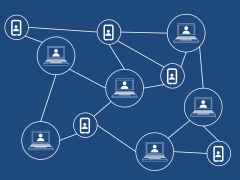Moving from on-premise to destination to distributed platforms and networks
SPONSORED INSIGHTS

Distributed Trade Platforms and Networks are a new paradigm
Most efforts to digitise global trade finance have been unsuccessful, mainly because of limitations of legacy trade platforms and networks managed by banks, corporates and fintechs. That means that trade transactions involving multiple parties still remain very costly, risky, complex and are mainly based on manual processes. These inefficiencies and siloed systems limit companies how, where, and with whom they can conduct and finance global trade.
Over the last decades, there have been two key paradigms in trade finance technology underpinning the digitisation and connectivity efforts in the market.
1st Paradigm: On-premise Software. Enterprise software systems are deployed as single instances hosted in data centers or on dedicated servers operated by each user. Usually, these systems are developed in-house as completely custom, proprietary software specific to that particular user.
While these on-premise software solutions have made internal processes faster, more digital, and more efficient, they still inject tremendous amounts of cost, risk, and friction into trade finance transactions involving parties outside of that on-premise system.
2nd Paradigm: Destination Platforms. In the 2000s, destination platforms emerged to address the problems of the first paradigm. They have attempted to digitise and streamline multi-party trade transactions by bringing all trading parties onto centralised “destination” platforms with all trade data stored in a single database owned and operated by a third-party vendor.
Mostly offered as Software-as-a-Service (SaaS), destination platforms create serious issues regarding data custody, residency, control, and privacy that have proven impossible to address. Moreover, while exchanging data and facilitating transactions between users on the same destination platform is easier, facilitating transactions between parties on different destination systems has proven to be just as costly, complex, bespoke, and risky as on-premise software.
Because of the inefficiencies of both paradigms mentioned above and with the advent of new technologies, emerged a brand-new paradigm: Distributed Trade Platforms and Networks.
Distributed trade platforms and networks have the potential to create a truly digital and connected trade ecosystem. It can help banks, corporate clients, and all others involved in global trade cut costs, eliminate friction, reduce risk, and enable new ways of doing business. The new paradigm is powered by blockchain technology that supports long overdue and fundamental improvements in the way we manage the flow of goods, assets, money, and credit in support of global trade.
These distributed trade platforms and networks allow users to connect-once-to-connect-many. Users require only a single interface and single integration to connect to and transact with all other participants across the network, regardless of which software system, platform, or network they use. Whereas today a corporate or a bank must perform N number of integrations for N number of counter-parties, with distributed trade platforms they must integrate only once to connect seamlessly and transact with all of their partners and clients.
This may sound like a solution from the future, but it is actually already a reality with the Marco Polo Network. Currently, the Marco Polo Network includes over two dozen banks and leverages innovative technology from TradeIX, R3 and Microsoft. The network has already conducted several successful transactions with major financial institutions and their corporate clients across the globe.
The Marco Polo Network, has some of its foundational infrastructure provided by Microsoft Azure. The network is using an innovative, integrated application stack comprised of Azure SQL Server, CosmosDB and Corda blockchain technology from R3
Because it’s an open, cloud-native network, Marco Polo Network members can share best practices, run pilot programs, and adjust the platform to meet their specific needs. Marco Polo has a host of Azure security controls such as Log Analytics, Security Center, Application Gateway, and Azure DDOS Protection implemented into the network infrastructure. This ensures that the Marco Polo Network is well-positioned to maintain the highest levels of trust, transparency, standards conformance for all members across the network.
The potential benefits of these new distributed platforms and networks such as Marco Polo in digitising and connecting the global trade ecosystem cannot go understated. In the same way that the internet transformed information technology and gave rise to the largest and most transformative businesses in human history, so too can distributed trade platforms and networks create a flatter, smarter, more connected, and more open ecosystem.











































